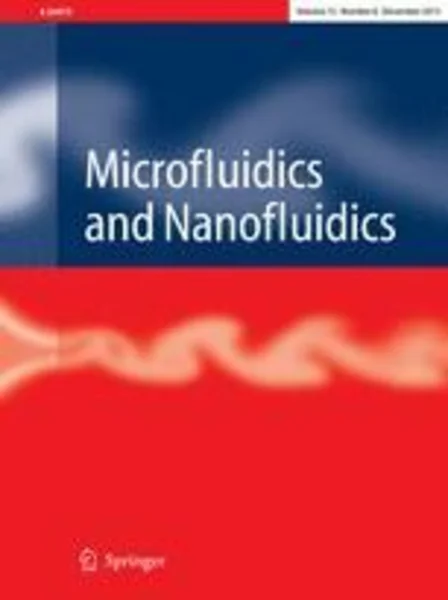-
irrigant transport into dental microchannels
جزئیات بیشتر مقاله- تاریخ ارائه: 1392/07/24
- تاریخ انتشار در تی پی بین: 1392/07/24
- تعداد بازدید: 873
- تعداد پرسش و پاسخ ها: 0
- شماره تماس دبیرخانه رویداد: -
the root canal system of a tooth is a complex geometrical entity, consisting not only of the main root canal, but also of accessory and lateral canals. bacteria can reside up to hundreds of micrometers inside those channels and may be difficult to reach for the antimicrobial agents with which root canals are irrigated during a root canal treatment. a combined numerical and experimental study was performed to assess the penetration rate of a root canal irrigant into the lateral canals and tubules, considering both diffusion and convection. the numerical model was validated experimentally using a fluorescent dye. convection was studied separately using a computational fluid dynamics model, validated with particle imaging velocimetry experiments. both diffusion and convection were found to be slow on the timescale of an irrigation procedure. the contribution of convection was limited to two canal diameters from the canal entrance, making diffusion the main irrigant transport mechanism. more than 10 min of fresh irrigant delivery was required to obtain an 86 % concentration of the irrigant at the far end of a tubule, in the ideal case of a straight tubule without reaction taking place. diffusion was even slower when the concentration at the lateral canal entrance was not kept constant, as in the case of a single delivery, which suggests that frequent irrigant replenishment and/or irrigant activation during a root canal treatment are beneficial. alternative methods should be considered to improve irrigant penetration into lateral canals and tubules.
مقالات جدیدترین رویدادها
-
استفاده از تحلیل اهمیت-عملکرد در ارائه الگوی مدیریت خلاقیت سازمانی و ارائه راهکار جهت بهبود
-
بررسی تاثیر ارزش وجوه نقد مازاد بر ساختار سرمایه شرکت های پذیرفته شده در بورس اوراق بهادار تهران
-
بررسی تأثیر سطح افشای ریسک بر قرارداد بدهی شرکت های پذیرفته شده در بورس اوراق بهادار تهران
-
بررسی تأثیر رتبه بندی اعتباری مبتنی بر مدل امتیاز بازار نوظهور بر نقد شوندگی سهام با تأکید بر خصوصی سازی شرکت ها
-
تأثیر آمیخته بازاریابی پوشاک ایرانی بر تصویر ذهنی مشتری پوشاک ایرانی (هاکوپیان)
-
بررسی تأثیر تمرینات عضلات دمی با استفاده از روش imt بر ظرفیت حیاتی تنفس
-
بررسی آزمایشگاهی ضریب آبگذری دریچه های استوانه ای
-
ملاحظات اقلیمی و مدیریت انرژی در معماری بومی (مطالعه موردی: استان هرمزگان)
-
real time implementation of h∞ loop shaping robust pss for multimachine power system using dspace
-
postglacial vegetation history as recorded from the subalpine lake ribno (nw rila mts), bulgaria
مقالات جدیدترین ژورنال ها
-
مدیریت و بررسی افسردگی دانش آموزان دختر مقطع متوسطه دوم در دروان کرونا در شهرستان دزفول
-
مدیریت و بررسی خرد سیاسی در اندیشه ی فردوسی در ادب ایران
-
واکاوی و مدیریت توصیفی قلمدان(جاکلیدی)ضریح در موزه آستان قدس رضوی
-
بررسی تاثیر خلاقیت، دانش و انگیزه کارکنان بر پیشنهادات نوآورانه کارکنان ( مورد مطالعه: هتل های 3 و 4 ستاره استان کرمان)
-
بررسی تاثیر کیفیت سیستم های اطلاعاتی بر تصمیم گیری موفق در شرکتهای تولیدی استان اصفهان (مورد مطالعه: مدیران شرکتهای تولیدی استان اصفهان)
-
بررسی نهادهای موثر و ارزیابی حاکمیت شرکتی و جایگاه آن در نظام بانکداری اسلامی و ایران
-
واکاوی جایگاه سواد رسانه ای انتقادی در نظام آموزش و پرورش ایران
-
بررسی عوامل موثر در تصمیم گیری زنان برای سقط عمدی جنین و نگرش اعتقادی و شرعی آنان در این باره
-
طرح حفظ مشتری (مطالعه موردی برای یک شرکت مشاوره شغلی و کاریابی در دو بافت خدمات b2c و b2b)
-
risks leading to cost overrun in construction projects: a systematic literature review




سوال خود را در مورد این مقاله مطرح نمایید :